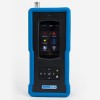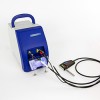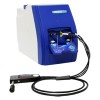
Plastics & Polymers
The rapid identification of plastics using Raman spectroscopy can aid in the sorting of plastics for quality
control in manufacturing, as well as for recycling. Since polymers have sharp, distinct peaks in their Raman
spectrum, they can be used as a signature of the material, that can be rapidly measured in the plant, lab or
anywhere else, in order to nondestructively provide the identity of the material. Both qualitative and quantitative
analysis can be done with Raman for plastics and polymers.
Raman spectroscopy is also used in the characterization of polymers and plastics to determine the composition,
which can include copolymers and blends, flame retardants, additives, antioxidants, and crystallinity. The
characterization of polymer laminates, and different layers can also be achieved with Raman.



